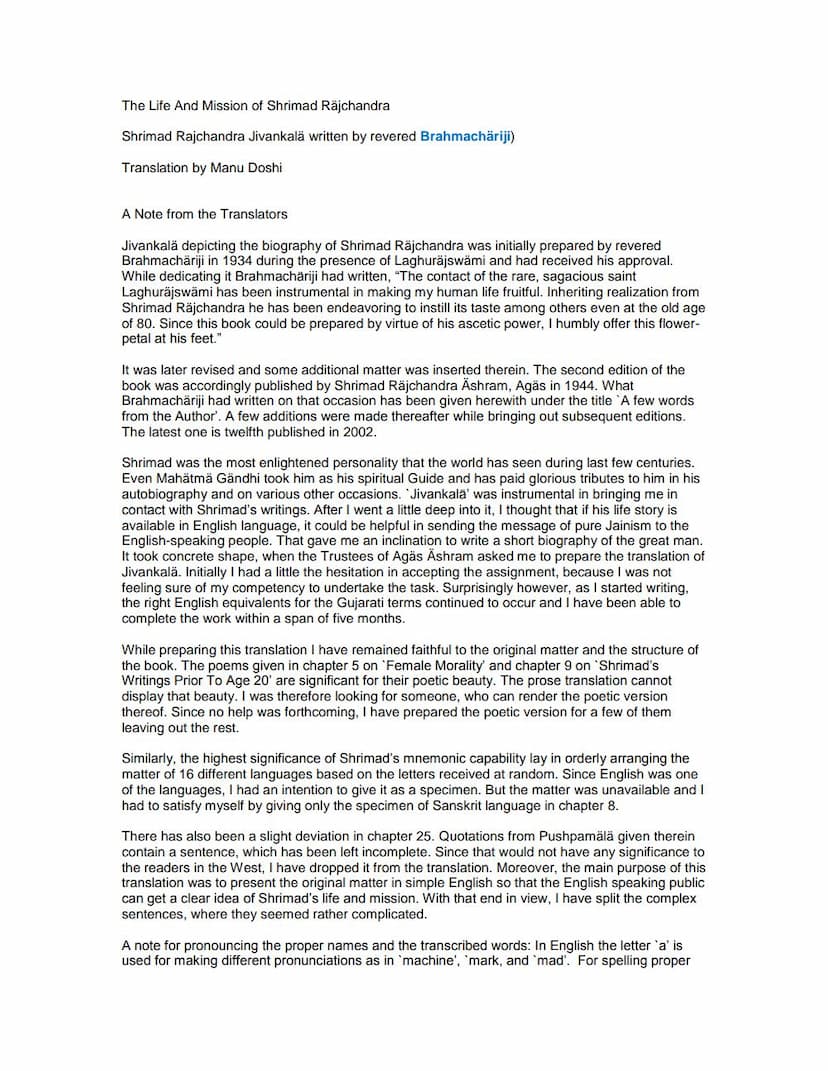Life Of Shrimad Rajchandra
Added to library: September 2, 2025

Summary
Here's a comprehensive summary of "The Life and Mission of Shrimad Rajchandra" by Manu Doshi, based on the provided text:
"The Life and Mission of Shrimad Rajchandra" is a biography detailing the extraordinary life and spiritual journey of Shrimad Rajchandra (1867-1901), a highly enlightened soul who significantly influenced spiritual thought in India. The book, translated by Manu Doshi, is based on the Gujarati work "Shrimad Rajchandra Jivankala" and aims to present Shrimad's life and teachings in simple English for a wider audience.
Early Life and Exceptional Talents:
- Birth and Background: Shrimad Rajchandra was born on November 9, 1867, in Vavania, Gujarat, to a family with a tradition of devotion. His birth coincided with the full moon day of Kartik, also the birthday of the renowned scholar Hemchandracharya.
- Prodigious Intellect: From a very young age, Shrimad displayed exceptional intellectual and mnemonic abilities. He could memorize texts after a single reading, possessed a mature understanding of complex philosophical concepts by the age of ten, and began writing poems at eight.
- Early Spiritual Inclinations: Even as a child, he contemplated profound questions about the soul, the universe, and the cause of suffering. His early life was marked by a unique blend of childhood innocence and deep spiritual inquiry.
- Recollection of Past Lives: At the age of seven, an encounter with death and the subsequent funeral rites sparked in him an awareness of previous lives, contributing significantly to his growing detachment from worldly affairs. This capacity for recollecting past lives is presented as a form of heightened intellectual knowledge, accessible under conducive karmic conditions.
- Mnemonic Prowess (Avadhan): Shrimad possessed extraordinary mnemonic capabilities, excelling in "Avadhan" performances. He could simultaneously engage in 16 to 52 complex activities, including playing multiple games, performing calculations, memorizing texts in various languages, and composing poems on given subjects. These performances, documented in newspapers of the time, showcased his remarkable mental dexterity and brought him considerable public acclaim.
Spiritual Development and Writings:
- Early Writings: Even before the age of sixteen, Shrimad authored significant works like "Striniti Bodhak" (Moral Code for Females), advocating for female education, and "Mokshamala" (Garland of Liberation), a foundational text for understanding Jainism, written at sixteen and a half. He also composed "Pushpamala" and "Bhavanabodhh," collections of maxims and reflections that aimed to foster detachment and spiritual understanding.
- Atmasiddhishastra: At the age of twenty-six, prompted by a request for a poetic rendering of spiritual truths, Shrimad composed "Atmasiddhishastra." This profound work, in a simple, accessible style, elucidates the nature of the soul, the concept of Karma, the path to liberation, and the guidance of a true Guru, presented as a dialogue between a preceptor and a pupil. It is considered a cornerstone of his spiritual teachings.
- The Role of a True Guru: A central theme in Shrimad's teachings is the indispensable role of a true, self-realized Guru. He emphasized that while scriptures provide guidance, true spiritual realization and the eradication of deep-seated ignorance and ego can only be achieved through direct contact with and devotion to an enlightened Master.
- Detachment and Renouncement: Throughout his life, Shrimad demonstrated profound detachment from worldly possessions and pleasures. Despite his involvement in business and family life, his inner inclination was always towards spiritual pursuits. His letters and diary entries reveal a constant aspiration for ultimate renouncement and union with the soul.
- Impact on Others: Shrimad's profound spiritual insight and compassionate guidance transformed the lives of many. Notable individuals like Mahatma Gandhi, Lallujiswami, Ambälälbhäi, and Saubhagyabhäi were deeply influenced by his teachings, with Gandhi considering him his spiritual guide. His ability to connect with people on a deep spiritual level and to articulate profound truths in simple language made his teachings accessible and impactful.
- Opposition and Misunderstanding: Despite his profound spiritual stature, Shrimad faced opposition and misunderstanding from some within the established religious orders, particularly due to his progressive views on religious practices and his emphasis on the essence of spirituality over ritualistic adherence.
Mission and Legacy:
- Revival of True Religion: Shrimad's mission was to revive the true essence of religion, which he saw as rooted in self-realization, compassion, and detachment. He aimed to cut through sectarian differences and guide people towards the universal truth of the soul.
- Param Shrut Prabhayak Mandal: In his later years, Shrimad established an organization to propagate spiritual knowledge and publish important Jain scriptures.
- Memorials and Shrimad Rajchandra Ashrams: Following his passing in 1901, various institutions and ashrams were established in his memory, such as the Shrimad Rajchandra Ashram at Agäs, which continue to serve as centers for spiritual learning and practice.
- Enduring Influence: Shrimad Rajchandra's teachings continue to inspire spiritual seekers. His emphasis on introspection, the importance of a true Guru, and the path of detachment are considered timeless principles for achieving spiritual liberation.
The book provides a detailed account of Shrimad's life, his exceptional intellectual and spiritual abilities, his profound philosophical insights, and his enduring impact on the spiritual landscape of India, highlighting his role as a beacon of true spiritual knowledge in a materialistic age.